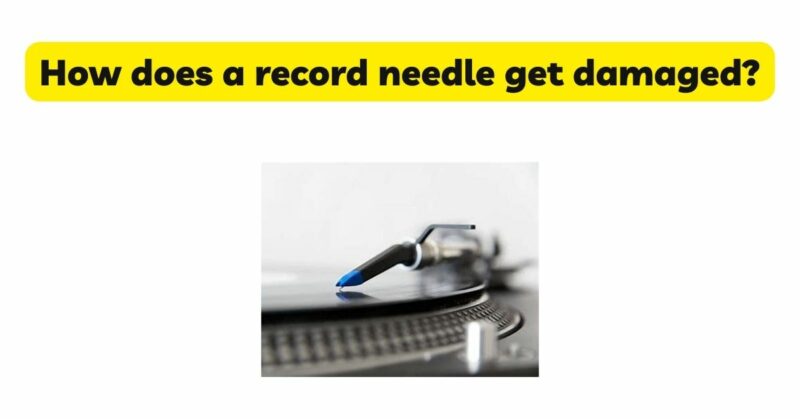The record needle, also known as the stylus, is a crucial component of a record player. It is responsible for tracking the grooves of vinyl records and translating the physical information into electrical signals that produce sound. However, the delicate nature of the needle makes it susceptible to damage over time. In this article, we will explore the various factors and behaviors that can lead to the damage of a record needle, enabling you to take preventative measures and extend the lifespan of this vital component.
- Normal Wear and Tear: Regular use of a record player will inevitably subject the needle to wear and tear. As the needle tracks the grooves of vinyl records, the friction and pressure gradually cause the tip of the stylus to wear down. The diamond tip of the needle may become dull or even chipped, compromising its ability to accurately read the grooves and produce high-quality sound. Over time, this normal wear and tear can lead to a diminished performance and ultimately necessitate the replacement of the needle.
- Improper Handling: Mishandling the record player and the needle can significantly contribute to its damage. Some common instances of improper handling include:
a. Dropping the Tonearm: Carelessly dropping the tonearm onto the record surface can cause a sudden impact that can damage the delicate stylus. It is important to lower the tonearm gently and ensure that it lands precisely in the groove without unnecessary force.
b. Incorrect Cartridge Installation: The needle is housed within the cartridge, which is mounted on the tonearm. Incorrect installation of the cartridge can put undue stress on the needle and its delicate components, leading to misalignment or damage. It is crucial to follow the manufacturer’s instructions carefully when installing or replacing cartridges.
c. Rough Handling of Records: Mishandling vinyl records, such as dropping or sliding them aggressively, can cause the needle to collide with the record’s surface. These impacts can damage the needle’s delicate tip or cause it to chip, compromising its ability to track the grooves accurately.
- Dust and Debris: Dust, debris, and dirt are common adversaries to the longevity of a record needle. When a vinyl record is played, static electricity can attract particles to the surface. Over time, these particles accumulate on the record’s grooves and can adhere to the needle. The presence of dust and debris on the needle not only affects the sound quality but can also cause increased wear as the needle tracks along the dirty grooves. Regular cleaning of both the records and the needle is essential to minimize the risk of damage.
- Playing Damaged or Poor Quality Records: Playing damaged or poor-quality records can have detrimental effects on the record needle. Records with deep scratches, warps, or excessive dirt and debris can cause the needle to skip or jump, leading to potential damage. The needle can also encounter difficulties when playing records with poorly aligned or improperly cut grooves. It is advisable to handle records with care, inspect them for visible damage, and clean them before each play to minimize the risk of needle damage.
- Excessive Tracking Force: The tracking force refers to the downward pressure exerted by the needle on the record’s surface. Applying excessive tracking force can accelerate the wear and tear on the needle, causing it to wear down more quickly. Each cartridge has a recommended tracking force range, and it is crucial to set the tracking force within this range to prevent unnecessary damage to the needle and the records.
- Incorrect Anti-Skate Adjustment: The anti-skate adjustment on a turntable helps counteract the inward force that naturally occurs as the needle tracks the record’s grooves. Incorrectly setting the anti-skate adjustment can lead to uneven pressure on the needle, resulting in poor tracking and potential damage. Proper adjustment of the anti-skate mechanism is essential to maintain the optimal performance and longevity of the needle.
- Environmental Factors: Environmental factors can also impact the lifespan of a record needle. Exposure to extreme temperatures or high humidity levels can degrade the needle’s materials over time. Storing the record player in dusty or dirty environments can increase the risk of debris buildup on the needle. It is advisable to keep the record player in a controlled environment with stable temperature and humidity levels to minimize the impact of these factors.
Conclusion: The record needle is a delicate and vital component of a record player, responsible for accurate tracking and sound reproduction. Understanding the factors that contribute to needle damage can help you take preventative measures and prolong its lifespan. By being mindful of proper handling techniques, avoiding damaged or poor-quality records, regularly cleaning records and the needle, and ensuring correct tracking force and anti-skate adjustments, you can minimize the risk of needle damage. By taking care of your record needle, you can continue to enjoy high-quality sound and preserve your vinyl collection for years to come.


